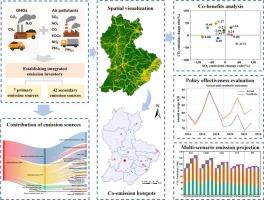Assessing synergistic effects of GHGs and APs in typical resource-based urban areas:Co-abatement analysis, policy evaluation, and multi-scenario projections
IF 11.2
1区 社会学
Q1 ENVIRONMENTAL STUDIES
引用次数: 0
Abstract
Resource-based cities are widely distributed across China and account for over 40 % of all cities. The synergistic control of greenhouse gases (GHGs) and air pollutants (APs) in these cities is thus critical for the high-quality green development of China, yet research in this area remains relatively limited. Accordingly, this study first developed a bottom-up integrated emission inventory of GHGs and APs for a representative Chinese mature resource-based city and conducted a detailed synergistic analysis covering the identification of emission correlations, compositional characteristics, spatial distribution, co-emission hotspots, evaluation of sectoral co-reduction, environmental policy effectiveness, and multi-scenario emission projections. Results showed strong correlations between CO2 and SO2, NOx, CO, PM10, and PM2.5. The spatial distribution of individual emissions of GHGs and APs, as well as their co-emission hotspots, were mainly located in southeastern plains, densely populated areas, industrial parks, and major transport routes. The coke making and chemical fiber industries within the industrial sector exhibited a trend of co-emission reduction for both CO2 and APs. Furthermore, the effectiveness of the “Three-year Action Plan to Fight Air Pollution” policy in improving the air quality of the study city was confirmed. In the future, the city should adopt more stringent and integrated strategies, including energy substitution, green technology upgrades, and resource recycling, to achieve co-benefits of pollution reduction and carbon mitigation. This study provides a scientific basis for co-control policy development in resource-based cities.

评估典型资源型城市地区温室气体和ap的协同效应:共同减排分析、政策评估和多情景预测
资源型城市分布广泛,占全国城市总数的40%以上。因此,城市温室气体和大气污染物的协同控制对中国的高质量绿色发展至关重要,但这方面的研究相对有限。为此,本研究首先构建了具有代表性的中国成熟资源型城市温室气体和ap自下而上的综合排放清单,并从排放相关性识别、组成特征、空间分布、共同排放热点、部门共同减排评价、环境政策有效性和多情景排放预测等方面进行了详细的协同分析。结果表明,CO2与SO2、NOx、CO、PM10和PM2.5之间存在很强的相关性。温室气体和总烟碱单项排放的空间分布及其共同排放热点主要分布在东南平原、人口密集地区、工业园区和交通要道等区域。工业部门内的焦炭和化纤行业均呈现CO2和APs共同减排的趋势。此外,“对抗空气污染三年行动计划”政策在改善研究城市空气质量方面的有效性得到了证实。未来,城市应采取更加严格和综合的战略,包括能源替代、绿色技术升级和资源回收,以实现减少污染和减少碳排放的共同效益。本研究为资源型城市协同控制政策的制定提供了科学依据。
本文章由计算机程序翻译,如有差异,请以英文原文为准。
求助全文
约1分钟内获得全文
求助全文
来源期刊

Environmental Impact Assessment Review
ENVIRONMENTAL STUDIES-
CiteScore
12.60
自引率
10.10%
发文量
200
审稿时长
33 days
期刊介绍:
Environmental Impact Assessment Review is an interdisciplinary journal that serves a global audience of practitioners, policymakers, and academics involved in assessing the environmental impact of policies, projects, processes, and products. The journal focuses on innovative theory and practice in environmental impact assessment (EIA). Papers are expected to present innovative ideas, be topical, and coherent. The journal emphasizes concepts, methods, techniques, approaches, and systems related to EIA theory and practice.
 求助内容:
求助内容: 应助结果提醒方式:
应助结果提醒方式:


